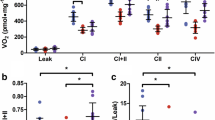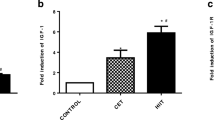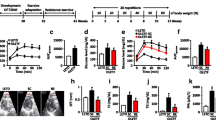Abstract
Diabetes mellitus (DM) increases the risk of heart failure after myocardial infarction (MI), and aggravates ventricular arrhythmias in heart failure patients. Although exercise training improves cardiac function in heart failure, it is still unclear how it benefits the diabetic heart after MI. To study the effects of aerobic interval training on cardiac function, susceptibility to inducible ventricular arrhythmias and cardiomyocyte calcium handling in DM mice after MI (DM-MI). Male type 2 DM mice (C57BLKS/J Lepr db /Lepr db) underwent MI or sham surgery. One group of DM-MI mice was submitted to aerobic interval training running sessions during 6 weeks. Cardiac function and structure were assessed by echocardiography and magnetic resonance imaging, respectively. Ventricular arrhythmias were induced by high-frequency cardiac pacing in vivo. Protein expression was measured by Western blot. DM-MI mice displayed increased susceptibility for inducible ventricular arrhythmias and impaired diastolic function when compared to wild type-MI, which was associated with disruption of cardiomyocyte calcium handling and increased calcium leak from the sarcoplasmic reticulum. High-intensity exercise recovered cardiomyocyte function in vitro, reduced sarcoplasmic reticulum diastolic calcium leak and significantly reduced the incidence of inducible ventricular arrhythmias in vivo in DM-MI mice. Exercise training also normalized the expression profile of key proteins involved in cardiomyocyte calcium handling, suggesting a potential molecular mechanism for the benefits of exercise in DM-MI mice. High-intensity aerobic exercise training recovers cardiomyocyte function and reduces inducible ventricular arrhythmias in infarcted diabetic mice.






Similar content being viewed by others
References
Ai X, Curran JW, Shannon TR, Bers DM, Pogwizd SM (2005) Ca2+/calmodulin-dependent protein kinase modulates cardiac ryanodine receptor phosphorylation and sarcoplasmic reticulum Ca2+ leak in heart failure. Circ Res 97:1314–1322. doi:10.1161/01.RES.0000194329.41863.89
Anderson ME, Brown JH, Bers DM (2011) CaMKII in myocardial hypertrophy and heart failure. J Mol Cell Cardiol 51:468–473. doi:10.1016/j.yjmcc.2011.01.012
Asbun J, Villarreal FJ (2006) The pathogenesis of myocardial fibrosis in the setting of diabetic cardiomyopathy. J Am Coll Cardiol 47:693–700. doi:10.1016/j.jacc.2005.09.050
Ather S, Wang W, Wang Q, Li N, Anderson ME, Wehrens XH (2013) Inhibition of CaMKII phosphorylation of RyR2 prevents inducible ventricular arrhythmias in mice with Duchenne muscular dystrophy. Heart Rhythm 10:592–599. doi:10.1016/j.hrthm.2012.12.016
Bauters C, Lamblin N, Mc Fadden EP, Van Belle E, Millaire A, de Groote P (2003) Influence of diabetes mellitus on heart failure risk and outcome. Cardiovasc Diabetol 2:1. doi:10.1186/1475-2840-2-1
Bers DM (2006) Altered cardiac myocyte Ca regulation in heart failure. Physiology (Bethesda, Md.) 21:380–387. doi:10.1152/physiol.00019.2006
Curran J, Brown KH, Santiago DJ, Pogwizd S, Bers DM, Shannon TR (2010) Spontaneous Ca waves in ventricular myocytes from failing hearts depend on Ca(2+)-calmodulin-dependent protein kinase II. J Mol Cell Cardiol 49:25–32. doi:10.1016/j.yjmcc.2010.03.013
Czyzk A, Krolewski AS, Szablowska S, Alot A, Kopczynski J (1980) Clinical course of myocardial infarction among diabetic patients. Diabetes Care 3:526–529. doi:10.2337/diacare.3.4.526
De Groote P, Lamblin N, Mouquet F, Plichon D, McFadden E, Van Belle E, Bauters C (2004) Impact of diabetes mellitus on long-term survival in patients with congestive heart failure. Eur Heart J 25:656–662. doi:10.1016/j.ehj.2004.01.010
Erickson JR, Anderson ME (2008) CaMKII and its role in cardiac arrhythmia. J Cardiovasc Electrophysiol 19:1332–1336. doi:10.1111/j.1540-8167.2008.01295.x
Erickson JR, Pereira L, Wang L, Han G, Ferguson A, Dao K, Copeland RJ, Despa F, Hart GW, Ripplinger CM, Bers DM (2013) Diabetic hyperglycaemia activates CaMKII and arrhythmias by O-linked glycosylation. Nature 502:372–376. doi:10.1038/nature12537
Fein F, Scheuer J (1990) Heart disease in diabetes mellitus: theory and practice. In: Porte DJ (ed) Rifkin H. Elsevier, New York, pp 812–823
George CH (2008) Sarcoplasmic reticulum Ca2+ leak in heart failure: mere observation or functional relevance? Cardiovasc Res 77:302–314. doi:10.1093/cvr/cvm006
Heusch G, Libby P, Gersh B, Yellon D, Bohm M, Lopaschuk G, Opie L (2014) Cardiovascular remodelling in coronary artery disease and heart failure. Lancet 383:1933–1943. doi:10.1016/S0140-6736(14)60107-0
Hollekim-Strand SM, Bjorgaas MR, Albrektsen G, Tjonna AE, Wisloff U, Ingul CB (2014) High-intensity interval exercise effectively improves cardiac function in patients with type 2 diabetes mellitus and diastolic dysfunction: a randomized controlled trial. J Am Coll Cardiol 64:1758–1760. doi:10.1016/j.jacc.2014.07.971
Li N, Wehrens XHT (2010) Programmed electrical stimulation in mice. J Vis Exp. doi:10.3791/1730
Miettinen H, Lehto S, Salomaa V, Mahonen M, Niemela M, Haffner SM, Pyorala K, Tuomilehto J (1998) Impact of diabetes on mortality after the first myocardial infarction. The FINMONICA Myocardial Infarction Register Study Group. Diabetes Care 21:69–75. doi:10.2337/diacare.21.1.69
Milberg P, Pott C, Frommeyer G, Fink M, Ruhe M, Matsuda T, Baba A, Klocke R, Quang TH, Nikol S, Stypmann J, Osada N, Muller FU, Breithardt G, Noble D, Eckardt L (2012) Acute inhibition of the Na(+)/Ca(2+) exchanger reduces proarrhythmia in an experimental model of chronic heart failure. Heart Rhythm 9:570–578. doi:10.1016/j.hrthm.2011.11.004
Oort RJv, McCauley MD, Dixit SS, Pereira L, Yang Y, Respress JL, Wang Q, Almeida ACD, Skapura DG, Anderson ME, Bers DM, Wehrens XHT (2010) Ryanodine receptor phosphorylation by calcium/calmodulin-dependent protein kinase II promotes life-threatening ventricular arrhythmias in mice with heart failureclinical perspective. Circulation 122:2669–2679. doi:10.1161/CIRCULATIONAHA.110.982298
Porter KE, Turner NA (2009) Cardiac fibroblasts: at the heart of myocardial remodeling. Pharmacol Ther 123:255–278. doi:10.1016/j.pharmthera.2009.05.002
Regan TJ, Wu CF, Yeh CK, Oldewurtel HA, Haider B (1981) Myocardial composition and function in diabetes. The effects of chronic insulin use. Circ Res 49:1268–1277. doi:10.1161/01.RES.49.6.1268
Robinson E, Cassidy RS, Tate M, Zhao Y, Lockhart S, Calderwood D, Church R, McGahon MK, Brazil DP, McDermott BJ, Green BD, Grieve DJ (2015) Exendin-4 protects against post-myocardial infarction remodelling via specific actions on inflammation and the extracellular matrix. Basic Res Cardiol 110:20. doi:10.1007/s00395-015-0476-7
Rytter L, Troelsen S, Beck-Nielsen H (1985) Prevalence and mortality of acute myocardial infarction in patients with diabetes. Diabetes Care 8:230–234. doi:10.2337/diacare.8.3.230
Shao CH, Wehrens XH, Wyatt TA, Parbhu S, Rozanski GJ, Patel KP, Bidasee KR (2009) Exercise training during diabetes attenuates cardiac ryanodine receptor dysregulation. J Appl Physiol 106:1280–1292. doi:10.1152/japplphysiol.91280.2008
Shehadeh A, Regan TJ (1995) Cardiac consequences of diabetes mellitus. Clin Cardiol 18:301–305. doi:10.1002/clc.4960180604
Stolen TO, Hoydal MA, Kemi OJ, Catalucci D, Ceci M, Aasum E, Larsen T, Rolim N, Condorelli G, Smith GL, Wisloff U (2009) Interval training normalizes cardiomyocyte function, diastolic Ca2+ control, and SR Ca2+ release synchronicity in a mouse model of diabetic cardiomyopathy. Circ Res 105:527–536. doi:10.1161/CIRCRESAHA.109.199810
Tjønna AE, Lee SJ, Rognmo Ø, Stølen TO, Bye A, Haram PM, Loennechen JP, Al-Share QY, Skogvoll E, Slørdahl SA, Kemi OJ, Najjar SM, Wisløff U (2008) Aerobic interval training versus continuous moderate exercise as a treatment for the metabolic syndrome a pilot study. Circulation 118:346–354. doi:10.1161/CIRCULATIONAHA.108.772822
Van de Werf F, Ardissino D, Betriu A, Cokkinos DV, Falk E, Fox KA, Julian D, Lengyel M, Neumann FJ, Ruzyllo W, Thygesen C, Underwood SR, Vahanian A, Verheugt FW, Wijns W, Task Force on the Management of Acute Myocardial Infarction of the European Society of C (2003) Management of acute myocardial infarction in patients presenting with ST-segment elevation. The Task Force on the Management of Acute Myocardial Infarction of the European Society of Cardiology. Eur Heart J 24:28–66. doi:10.1016/S0195-668X(02)00618-8
Wisløff U, Najjar SM, Ellingsen Ø, Haram PM, Swoap S, Al-Share Q, Fernström M, Rezaei K, Lee SJ, Koch LG, Britton SL (2005) Cardiovascular risk factors emerge after artificial selection for low aerobic capacity. Science 307:418–420. doi:10.1126/science.1108177
Wisløff U, Støylen A, Loennechen JP, Bruvold M, Rognmo Ø, Haram PM, Tjønna AE, Helgerud J, Slørdahl SA, Lee SJ, Videm V, Bye A, Smith GL, Najjar SM, Ellingsen Ø, Skjærpe T (2007) Superior cardiovascular effect of aerobic interval training versus moderate continuous training in heart failure patients. Circulation 115:3086–3094. doi:10.1161/CIRCULATIONAHA.106.675041
Yue L, Xie J, Nattel S (2011) Molecular determinants of cardiac fibroblast electrical function and therapeutic implications for atrial fibrillation. Cardiovasc Res 89:744–753. doi:10.1093/cvr/cvq329
Zethelius B, Gudbjornsdottir S, Eliasson B, Eeg-Olofsson K, Cederholm J, Swedish National Diabetes R (2014) Level of physical activity associated with risk of cardiovascular diseases and mortality in patients with type-2 diabetes: report from the Swedish National Diabetes Register. Eur J Prev Cardiol 21:244–251. doi:10.1177/2047487313510893
Zhao Z, Fefelova N, Shanmugam M, Bishara P, Babu GJ, Xie LH (2011) Angiotensin II induces afterdepolarizations via reactive oxygen species and calmodulin kinase II signaling. J Mol Cell Cardiol 50:128–136. doi:10.1016/j.yjmcc.2010.11.001
Acknowledgments
We thank R. Røsbjørgen for technical assistance, J. Nauman for statistical support, and G. J. J. Silva, and J. B. N. Moreira for very helpful advices. This study was funded by K.G. Jebsen Foundation, The Norwegian Council on Cardiovascular Disease, The Research Council of Norway and Liaison Committee between the Central Norway Regional Health Authority (RHA), the Norwegian University of Science and Technology (NTNU), and the European Commission (FP7-Health-2013; OPTIMEX-602405).
Conflict of interest
On behalf of all the authors, the corresponding author states that there is no conflict of interest.
Author information
Authors and Affiliations
Corresponding author
Electronic supplementary material
Below is the link to the electronic supplementary material.
Rights and permissions
About this article
Cite this article
Rolim, N., Skårdal, K., Høydal, M. et al. Aerobic interval training reduces inducible ventricular arrhythmias in diabetic mice after myocardial infarction. Basic Res Cardiol 110, 44 (2015). https://doi.org/10.1007/s00395-015-0502-9
Received:
Revised:
Accepted:
Published:
DOI: https://doi.org/10.1007/s00395-015-0502-9




